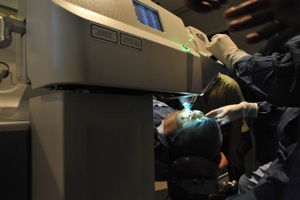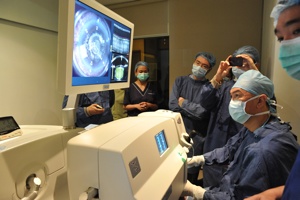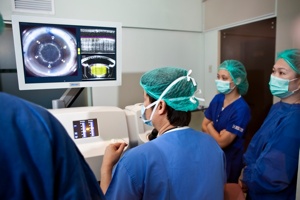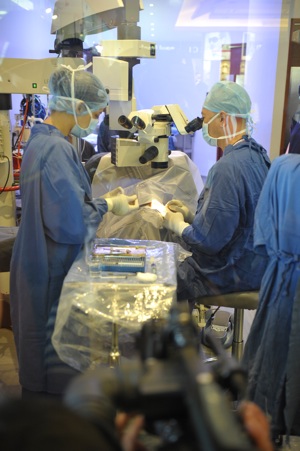
A new treatment for cataracts has just been unveiled by American Eye Center (AEC), which promises to provide patients with the most advanced all-laser cataract procedure---the first of its kind in Asia.
Dubbed the Alcon LenSx femtosecond laser surgery, this new equipment brings an unprecedented level of safety, speed and precision in treating cataracts, and enhances the host of options for surgical-based methods that AEC offers its clients.

From a surgical perspective, advances in cataract treatment have improved the way ophthalmologists deal with this condition in the past two decades. We have seen how the merger of technology and surgical ingenuity contributed to making cataract surgery the modern-day miracle that it is today. Currently, we can remove the cataract through a very small (2-3mm) incision in the eyeball using fine surgical blades and implant a multifocal intraocular lens (IOL) that restores full functional vision in patients after surgery. This is called “Phacoemulsification”, presently the standard in cataract practice worldwide. Unfortunately, this procedure has often been mistakenly referred to as “laser eye surgery”—which it is NOT. It is more appropriate to call this procedure “small-incision cataract surgery”, “sutureless cataract surgery”, or “no-stitch cataract surgery” for the layman. True laser-assisted cataract surgery has never been available to patients until today—with the introduction of the Alcon LenSx femtosecond laser surgery.
The Alcon LenSX femtosecond laser differs from the traditional methods of cataract surgery by the absence of the blade. By using very short yet intense bursts of near-infrared light, the Alcon LenSX femtosecond laser technology is able to create extremely precise subsurface cuts without manual intervention The blades used to create the small incisions in the eye have been completely replaced by this laser, making the incisions more precise and predictable. In addition, the circular opening that is created in the human lens in order to access the cataract (called a capsulotomy) which was traditionally performed by human hands has now been replaced by the femtosecond laser, making the capsulotomies more architecturally round and centered. Studies have shown that this is very important in intraocular lens stability and refractive predictability of surgical outcomes (In one study by the American Academy of Ophthalmology, femtosecond laser incisions achieved perfect capsulotomy diameter accuracy in 100 percent of cases). Finally, the actual cataract is also fragmented by the femtosecond laser making it much easier and less traumatic for the surgeon to remove and clean it up prior to placement of the IOL. In short, the femtosecond laser has replaced many of the steps in the cataract surgery that were previously performed by human hands, i.e., resulting in less surgical error and better predictability of outcomes. Results are more precise than any other previous or current methods of cataract surgery.

Dr. Cesar Ramon G. Espiritu, who specializes in Cornea, External Disease treatment at AEC, said that this new technology shows the company’s commitment to provide the best eye care to its patients.
“The Alcon LenSx femtosecond laser surgery is currently the most advanced method for cataract treatment, and we’re proud to be the first in Asia to offer it,” he says. “We want thousands of Filipinos suffering from cataracts to see that treatment is now even faster, much safer, more precise and definitely pain-free.”

Cataract is the leading cause of blindness in the Philippines, with an estimated half a million Filipinos blind or having some degree of visual impairment. This disease, which hits almost everyone due to aging, involves the gradual formation of a cloudy film in the lens of the eye, varying in degree from slight to complete opacity, and obstructing the passage of light.
Espiritu emphasizes that patients must decide their preferred method of surgery together with an expert ophthalmologist. AEC is backed by a team of Associated Eye Specialists, the most experienced and longest-running EyeMD group practice in the country, which comprises 17 doctors with various subspecialties. AEC also boasts a staff of highly qualified optometrists, nurses and counselors to provide patients with personalized quality eye care.
The American Eye Center has been breaking new ground when it comes to ophthalmic care since its establishment in 1995. Accredited with the Department of Health and the Philippine Health Insurance Corporation, AEC is fully equipped with branches located at the Level 5, EDSA Shangri-La Plaza, and at the Level 4 of Greenbelt 5, Makati City. For inquiries, call 636-0762 or 729-EYES (3937) or visit www.americaneye.com.ph, follow eyetweets in Twitter, and “like our account” in Facebook.



